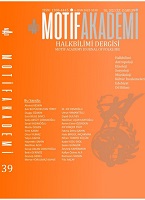REPRESENTATIONS OF DEATH IN THE STORY OF DELİ DUMRUL AND EVERYMAN
REPRESENTATIONS OF DEATH IN THE STORY OF DELİ DUMRUL AND EVERYMAN
Author(s): Seda Aksüt ÇobanoğluSubject(s): Comparative Study of Literature, Turkish Literature, British Literature
Published by: Motif Halk Oyunları Eğitim ve Öğretim Vakfı
Keywords: Deli Dumrul; Everyman; death; comparative literature; culture;
Summary/Abstract: Death is a reality of human life that everybody will experience sooner or later. As a universal concept, the reality and fear of death can be observed in many literary works. The Story of Deli Dumrul Son of Duha Kodja and Everyman are among the literary works in which death is included as a cultural representation. The Story of Deli Dumrul is one of the stories from the Book of Dede Korkut and tells the adventures of Deli Dumrul, who challenges Azrael. Everyman is an allegorical English morality play, in which the protagonist Everyman’s journey of death and reckoning process are told. Both of the texts belong to medieval times, and the concept of death is not handled as just a literary theme but also a fact of life in each. In the Story of Deli Dumrul, as a result of his challenge to Azrael, Deli Dumrul is punished by God via the decision of his death. In Everyman, the sinful character Everyman’s process of pre-death is depicted as a spiritual journey on the basis of the Christian religion. Each text deals with the concept of death in a different cultural context. Hence, they each represent death in accordance with their cultural features. In each text, death is personified and included as a character, namely Azrael and Death. The primary objective of this study is to discuss the way death is portrayed as a character in the light of the cultural milieu in these texts. For this objective, the way death is represented in relation to other characters is tried to be examined and analyzed in a comparative way with regard to the texts’ sociocultural and religious background. The arguments are discussed with relevant references to the literary texts mentioned. In the study, representations of death are investigated in terms of three aspects: death as God’s wrath; death as a threatening and disturbing character; death as a trigger in the protagonists’ awakening/rationalization process. Thus, representations of death in the mentioned texts are discussed in relation to God’s and the protagonists’ attitudes and actions. This study also investigates how cultural patterns are reflected in each text on the basis of representations of death. Death, in the form of a character in both of the texts, functions as a trigger by which the protagonists go through a maturation process. The fact that death’s being a trigger in the maturation process of the protagonists is common in both texts confirms that facing the reality of death has a didactic effect/function and that the representations of death in literary texts could have an educational aspect.
Journal: Motif Akademi Halkbilimi Dergisi
- Issue Year: 15/2022
- Issue No: 39
- Page Range: 726-742
- Page Count: 17
- Language: English

